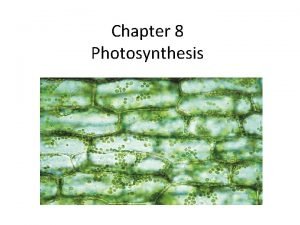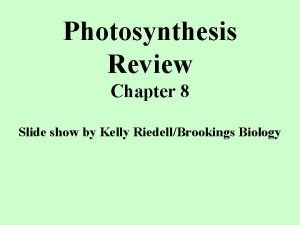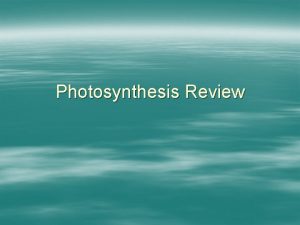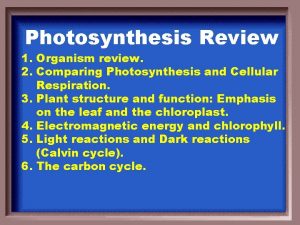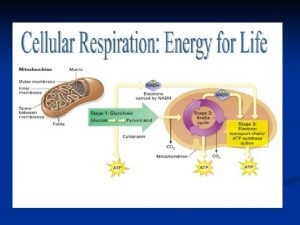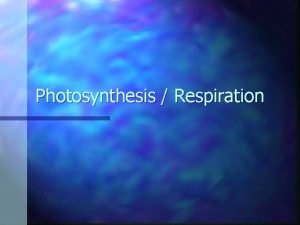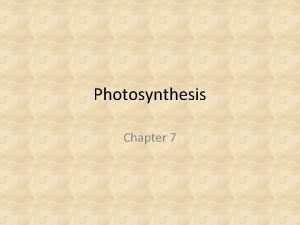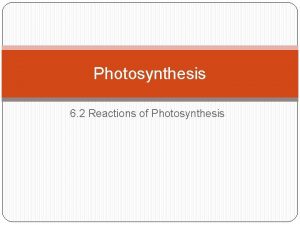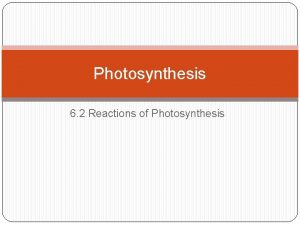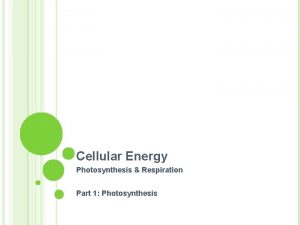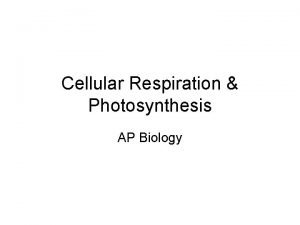Photosynthesis Review What is photosynthesis Photosynthesis is the





























- Slides: 29

Photosynthesis Review

What is photosynthesis? -Photosynthesis is the process by which green plants and certain other organisms use the energy of light to convert carbon dioxide and water into glucose. -The glucose can be then used in cellular respiration, used structurally (cellulose), or stored (starch).

Glucose source for animals -Humans and other animals depend on glucose as an energy source, but they are unable to produce it on their own and must rely ultimately on the glucose produced by plants. -Photosynthesis provides the basic energy source for virtually all organisms.

Take a breath… -An extremely important byproduct of photosynthesis is oxygen, the t same oxygen humans and other animals breathe. -Plants increase the net supply of oxygen because they produce more oxygen in photosynthesis than they actually consume in cellular respiration.

Overall Equation for Photosynthesis

Pigments of plants -Pigments are chemical compounds which reflect only certain wavelengths of visible light. -This makes them appear "colorful".

Pigments -Plants gather the sun’s energy with these light-absorbing molecules. -The plants’ principal pigment is chlorophyll.

Leaf structures - A leaf takes in carbon dioxide through openings called stomata, small pores on the underside of the leaf. Stomata open to let carbon dioxide in and oxygen out. They close to prevent water loss when temperatures are high. -Water enters through the roots into tube like vascular tissue where it is transported to the cells where it is needed.

Where does photosynthesis occur? -Photosynthesis occurs in leaves and green stems within specialized cell structures called chloroplasts that surround the central vacuole. -One plant leaf is composed of tens of thousands of cells, and each cell contains 40 to 50 chloroplasts.

Chloroplast Structure Thylakoid- flattened, membrane bound sacs Granum- a stack of thylakoids Stroma- fluid outside thylakoid

Energy Collection -Because light is a form of energy, any compound that absorbs light absorbs energy. Chlorophyll absorbs visible light especially well. -When chlorophyll absorbs light, a large fraction of the light energy is transferred to electrons. -Chlorophyll’s high-energy electrons are the key to photosynthesis working.

Stages Photosynthesis is divided into two stages: 1. Light –dependent reactions 2. Light-independent reactions (also called the Calvin Cycle)

Light-Dependent Reaction -In the first stage, the light-dependent reaction, the chloroplast traps light energy in electrons found in chlorophyll, exciting the electrons. The electrons are passed to the ETC, where they are converted into chemical energy to be used in the second stage of photosynthesis.

Light-Dependent Reactions

Oxygen Production -A source of electrons to replace those lost by chlorophyll to the ETC is needed. -Enzymes break water into H+ ions (passed to ETC), electrons (back to chlorophyll), and oxygen gas. - This oxygen released is the source of nearly all the oxygen in our atmosphere.

Summary of Light. Dependent Reactions -The light-dependent reactions produce oxygen gas and ATP, which provides the energy needed to build high-energy sugars from low-energy carbon dioxide in the next stage.

Light-Independent Reactions -No light is required to power the light-independent reactions, but products of the first stage are used. -The light-independent reactions take place outside thylakoids, in the stroma.

Light-Independent Reactions -During light-independent reactions, ATP is used to produce high-energy sugars(stable) from carbon dioxide. -Also known as the Calvin Cycle….

Summary of the Calvin Cycle

Summary of the Calvin Cycle -When other organisms eat plants, they can use the energy and raw materials stored in plants. - A single six carbon sugar is produced, but 6 carbon dioxide molecules are removed from the atmosphere to make it.

The End Results -The two sets of photosynthetic reactions work together—the lightdependent reactions trap the energy of sunlight in chemical form, and the lightindependent reactions use that chemical energy to produce stable, high -energy sugars from carbon dioxide and water. In the process, animals, including humans, get food an atmosphere filled with oxygen.

Factors Affecting Photosynthesis What factors affect the rate of photosynthesis? -Among the most important factors that affect photosynthesis are 1. Temperature 2. light intensity 3. availability of water

Temperature, Light, and Water -The reactions of photosynthesis are made possible by enzymes that function best between 0°C and 35°C. -Temperatures above or below this range may affect those enzymes, slowing down the rate of photosynthesis or stopping it entirely.

Temperature, Light, and Water -High light intensity increases the rate of photosynthesis. -After the light intensity reaches a certain level, however, the plant reaches its maximum rate of photosynthesis, as is seen in the graph.

Temperature, Light, and Water -Because water is one of the raw materials in photosynthesis, a shortage of water can slow or even stop photosynthesis and damage plant tissues. -Plants that live in dry conditions often have waxy coatings on their leaves to reduce water loss. They may also have biochemical adaptations that make photosynthesis more efficient under dry conditions.

Comparing Photosynthesis and Cellular Respiration – What is the relationship between photosynthesis and cellular respiration? – Photosynthesis removes carbon dioxide from the atmosphere, and cellular respiration puts it back. Photosynthesis releases oxygen into the atmosphere, and cellular respiration uses that oxygen to release energy from food.

Comparing Photosynthesis and Cellular Respiration – The release of energy by cellular respiration takes place in plants, animals, fungi, protists, and most bacteria. – Energy capture by photosynthesis occurs only in plants, algae, and some bacteria.

Comparing Photosynthesis and Cellular Respiration – Photosynthesis and cellular respiration are opposite processes. – The energy flows in opposite directions. Photosynthesis “deposits” energy, and cellular respiration “withdraws” energy. – The reactants of cellular respiration are the products of photosynthesis and vice versa.

Photosynthesis and Cellular Respiration
 Atp and adp cycle
Atp and adp cycle What are the products of photosynthesis
What are the products of photosynthesis Các châu lục và đại dương trên thế giới
Các châu lục và đại dương trên thế giới ưu thế lai là gì
ưu thế lai là gì Môn thể thao bắt đầu bằng chữ đua
Môn thể thao bắt đầu bằng chữ đua Tư thế ngồi viết
Tư thế ngồi viết Thẻ vin
Thẻ vin Hát kết hợp bộ gõ cơ thể
Hát kết hợp bộ gõ cơ thể Cái miệng nó xinh thế chỉ nói điều hay thôi
Cái miệng nó xinh thế chỉ nói điều hay thôi Từ ngữ thể hiện lòng nhân hậu
Từ ngữ thể hiện lòng nhân hậu Trời xanh đây là của chúng ta thể thơ
Trời xanh đây là của chúng ta thể thơ Tư thế ngồi viết
Tư thế ngồi viết V cc cc
V cc cc Voi kéo gỗ như thế nào
Voi kéo gỗ như thế nào Thơ thất ngôn tứ tuyệt đường luật
Thơ thất ngôn tứ tuyệt đường luật Hươu thường đẻ mỗi lứa mấy con
Hươu thường đẻ mỗi lứa mấy con Thế nào là hệ số cao nhất
Thế nào là hệ số cao nhất Diễn thế sinh thái là
Diễn thế sinh thái là đại từ thay thế
đại từ thay thế Frameset trong html5
Frameset trong html5 Vẽ hình chiếu vuông góc của vật thể sau
Vẽ hình chiếu vuông góc của vật thể sau Làm thế nào để 102-1=99
Làm thế nào để 102-1=99 Thế nào là mạng điện lắp đặt kiểu nổi
Thế nào là mạng điện lắp đặt kiểu nổi Mật thư anh em như thể tay chân
Mật thư anh em như thể tay chân Lời thề hippocrates
Lời thề hippocrates Vẽ hình chiếu đứng bằng cạnh của vật thể
Vẽ hình chiếu đứng bằng cạnh của vật thể Chụp phim tư thế worms-breton
Chụp phim tư thế worms-breton Quá trình desamine hóa có thể tạo ra
Quá trình desamine hóa có thể tạo ra Khi nào hổ mẹ dạy hổ con săn mồi
Khi nào hổ mẹ dạy hổ con săn mồi Các châu lục và đại dương trên thế giới
Các châu lục và đại dương trên thế giới
